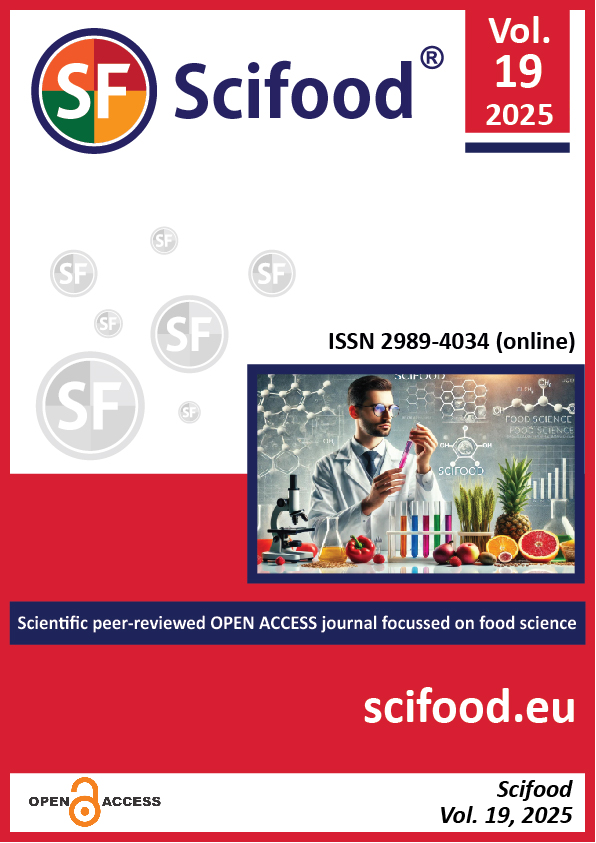Optimisation of the composition of мelon-based sorbets using simplex-centroid processing system
DOI:
https://doi.org/10.5219/scifood.11Keywords:
melon, technology, optimization, simplex-centroid system, sensory evaluationAbstract
Technology and formulation of various compositions of melon-based sorbets, enriched with additives of plant origin: fruits (apples, pears, plums, lemons), and vegetables (beetroot, red cabbage, sorrel leaves), were developed. Regression equations on the influence of formulation composition of three variants of melon-based sorbets on their sensory evaluation with high determination accuracy were derived. The coefficient of determination varies from 92.71% to 97.2%, which allows us to determine the zone where indicators have their maximum values. Using the simplex–centroid processing system the composition of melon-based sorbets was optimized, and their maximum sensory evaluation was determined with an optimal composition ratio: Zhelsiz Tunde – 50.6% of melon, 3% of beetroot, 6% of lemon and 25% of pears; Kokoray Shalgyn – 48.8% of melon, 3% of sorrel, 8% of lemon and 25% of apples; Kystyn Syzy – 46.8% of melon, 7% of red cabbage, 8% of lemon and 23% of plums. The developed compositions of melon-based sorbets were subjected to organoleptic evaluation using a scoring system from 1 to 10 points, and the reflecting surfaces were presented. The results confirm that using melon as the main raw material and enriching it with additives of plant origin allows for the preparation of functional, low-calorie dietary frozen desserts.
References
1. Yerenova, B., & Pronina, Yu. (2018). Influence of the low-temperature storage mode on qualitative indicators of melon sorbe. Scientific Works of University of Food Technologies, (Vol. 65, Issue 1, p. 18-23). https://uft-plovdiv.bg/site_files/file/scienwork/scienworks_2018/docs/1-2.pdf
2. Putradamni, A. M., & Pramitasari, R. (2024). Formula optimization, physicochemical characterization, and sensory evaluation of beetroot-based blended frozen dessert. In Food Chemistry Advances (Vol. 4, p. 100672). Elsevier BV. https://doi.org/10.1016/j.focha.2024.100672
3. Yerenova, B. Y., & Pronina, Yu. G. (2020). Progressive technology of functional melon-based products of long-term storage (monograph). Almaty: V.T.O Creative & Marketing Laboratory LLP. https://library.atu.edu.kz/files/63515/
4. Petkova, T., Doykina, P., Alexieva, I., Mihaylova, D., & Popova, A. (2022). Characterization of Fruit Sorbet Matrices with Added Value from Zizyphus jujuba and Stevia rebaudiana. In Foods (Vol. 11, Issue 18, p. 2748). MDPI AG. https://doi.org/10.3390/foods11182748
5. Malgor, M., Sabbione, A. C., & Scilingo, A. (2020). Amaranth Lemon Sorbet, Elaboration of a Potential Functional Food. In Plant Foods for Human Nutrition (Vol. 75, Issue 3, pp. 404–412). Springer Science and Business Media LLC. https://doi.org/10.1007/s11130-020-00818-y
6. Przybylski, W., Sionek, B., Jaworska, D., Spychalska, A., & Rupińska, M. (2020). Wpływ dodatku inuliny na jakość sorbetów owocowych i warzywnych. In Zywnosc Nauka Technologia Jakosc/Food Science Technology Quality (Vol. 124, Issue 3, pp. 66–76). Polskie Towarzystwo Technologow Zywnosci Wydawnictwo Naukowe PTTZ. https://doi.org/10.15193/zntj/2020/124/348
7. Palka, A., & Skotnicka, M. (2022). The Health-Promoting and Sensory Properties of Tropical Fruit Sorbets with Inulin. In Molecules (Vol. 27, Issue 13, p. 4239). MDPI AG. https://doi.org/10.3390/molecules27134239
8. Masselot, V., Bosc, V., & Benkhelifa, H. (2021). Analyzing the microstructure of a fresh sorbet with X-ray micro-computed tomography: Sampling, acquisition, and image processing. In Journal of Food Engineering (Vol. 292, p. 110347). Elsevier BV. https://doi.org/10.1016/j.jfoodeng.2020.110347
9. Konstantas, A., Stamford, L., & Azapagic, A. (2020). A framework for evaluating life cycle eco-efficiency and an application in the confectionary and frozen-desserts sectors. In Sustainable Production and Consumption (Vol. 21, pp. 192–203). Elsevier BV. https://doi.org/10.1016/j.spc.2019.12.006
10. Lee, L. Y., Chin, N. L., Christensen, E. S., Lim, C. H., Yusof, Y. A., & Talib, R. A. (2018). Applications and effects of monoglycerides on frozen dessert stability. In LWT (Vol. 97, pp. 508–515). Elsevier BV. https://doi.org/10.1016/j.lwt.2018.07.020
11. Landikhovskaya, A. V., & Tvorogova, A. A. (2021). Ice cream and frozen desserts nutrient compositions: current trends of researches. In Food systems (Vol. 4, Issue 2, pp. 74–81). The Gorbatov’s All-Russian Meat Research Institute. https://doi.org/10.21323/2618-9771-2021-4-2-74-81
12. GOST 8756.21-89. (1989). Fruit and vegetable products. Methods for determination of fat content.
13. GOST ISO 2173-2013. (2013). Products of processing fruits and vegetables. Refractometric method of determination of solids.
14. GOST 29059-91. (1991). Products of fruit and vegetables processing. Titration method for pectin substances.
15. B. Medvedkov, E., E. Yerenova, B., G. Pronina, Yu., D. Penov, M., D. Bilozerceva, O., & V. Kondratiuk, N. (2022). Extraction and characterization of pectins from melon peels: experimental review. In Journal of Chemistry and Technologies (Vol. 29, Issue 4, pp. 650–659). Oles Honchar Dnipropetrovsk National University. https://doi.org/10.15421/jchemtech.v29i4.252250
16. GOST R 53152-2008. (2008). Food products. Determination of PAHs by HPLC method.
17. Brand-Williams, W., Cuvelier, M. E., & Berset, C. (1995). Use of a free radical method to evaluate antioxidant activity. In LWT - Food Science and Technology (Vol. 28, Issue 1, pp. 25–30). Elsevier BV. https://doi.org/10.1016/s0023-6438(95)80008-5
18. Benzie, I. F. F., & Strain, J. J. (1996). The Ferric Reducing Ability of Plasma (FRAP) as a Measure of “Antioxidant Power”: The FRAP Assay. In Analytical Biochemistry (Vol. 239, Issue 1, pp. 70–76). Elsevier BV. https://doi.org/10.1006/abio.1996.0292
19. GOST ISO 750-2013. (2013). Fruit and vegetable products. Determination of titratable acidity.
20. Cornell, J. A. (2002). Experiments with Mixtures. In Wiley Series in Probability and Statistics. Wiley. https://doi.org/10.1002/9781118204221
21. Jensen, W. A. (2017). Response Surface Methodology: Process and Product Optimization Using Designed Experiments 4th edition. In Journal of Quality Technology (Vol. 49, Issue 2, pp. 186–188). Informa UK Limited. https://doi.org/10.1080/00224065.2017.11917988
22. Akalın, H., Kınık, Ö., & Şatır, G. (2024). Manufacturing plant-based non-dairy and probiotic frozen desserts and their impact on physicochemical, sensory and functional aspects. In Journal of Food Science and Technology (Vol. 61, Issue 10, pp. 1874–1883). Springer Science and Business Media LLC. https://doi.org/10.1007/s13197-024-05964-8
23. Iatridi, V., Hayes, J. E., & Yeomans, M. R. (2019). Reconsidering the classification of sweet taste liker phenotypes: A methodological review. In Food Quality and Preference (Vol. 72, pp. 56–76). Elsevier BV. https://doi.org/10.1016/j.foodqual.2018.09.001
24. Palka, A., & Wilczyńska, A. (2023). Storage Quality Changes in Craft and Industrial Blueberry, Strawberry, Raspberry and Passion Fruit-Mango Sorbets. In Foods (Vol. 12, Issue 14, p. 2733). MDPI AG. https://doi.org/10.3390/foods12142733
25. Yerenova, B., Pronina, Y., Penov, N., Mihalev, K., Kalcheva-Karadzhova, K., Dinkova, R., & Shikov, V. (2019). Optimization of the Mixed Melon-berry Juice Composition, Using Simplex Centroid Experimental Design. “Prof. Marin Drinov” Publishing House of Bulgarian Academy of Sciences. https://doi.org/10.7546/crabs.2019.12.16
26. Wang, Y., Do, T., Marshall, L. J., & Boesch, C. (2023). Effect of two-week red beetroot juice consumption on modulation of gut microbiota in healthy human volunteers – A pilot study. In Food Chemistry (Vol. 406, p. 134989). Elsevier BV. https://doi.org/10.1016/j.foodchem.2022.134989
27. Fernando, G. S. N., Sergeeva, N. N., Frutos, M. J., Marshall, L. J., & Boesch, C. (2022). Novel approach for purification of major betalains using flash chromatography and comparison of radical scavenging and antioxidant activities. In Food Chemistry (Vol. 385, p. 132632). Elsevier BV. https://doi.org/10.1016/j.foodchem.2022.132632
28. Tran, T. T. T., Cousin, F. J., Lynch, D. B., Menon, R., Brulc, J., Brown, J. R.-M., O’Herlihy, E., Butto, L. F., Power, K., Jeffery, I. B., O’Connor, E. M., & O’Toole, P. W. (2019). Prebiotic supplementation in frail older people affects specific gut microbiota taxa but not global diversity. In Microbiome (Vol. 7, Issue 1). Springer Science and Business Media LLC. https://doi.org/10.1186/s40168-019-0654-1
29. You, Y., Song, H., Yan, C., Ai, C., Tong, Y., Zhu, B., & Song, S. (2022). Dietary fibers obtained from Caulerpa lentillifera prevent high-fat diet-induced obesity in mice by regulating the gut microbiota and metabolite profiles. In Food & Function (Vol. 13, Issue 21, pp. 11262–11272). Royal Society of Chemistry (RSC). https://doi.org/10.1039/d2fo01632j
30. Zhao, J., Ji, Y., Tian, G., Zheng, Y., Sang, Y., & Gao, J. (2024). Pear pomace soluble dietary fiber suppresses fat deposition in high fat diet-fed mice by regulating the ADPN-AMPK/PPAR-α signaling pathway. In Journal of Functional Foods (Vol. 122, p. 106483). Elsevier BV. https://doi.org/10.1016/j.jff.2024.106483
31. McCalla, G., & Smith, B. (2024). Physiologic Effects of Hibiscus sabdariffa (Sorrel) on Biological Systems: Advances in Sorrel Research. In The Natural Products Journal (Vol. 14, Issue 7). Bentham Science Publishers Ltd. https://doi.org/10.2174/0122103155273914231206094057
32. Mierczak, K., & Garus-Pakowska, A. (2024). An Overview of Apple Varieties and the Importance of Apple Consumption in the Prevention of Non-Communicable Diseases—A Narrative Review. In Nutrients (Vol. 16, Issue 19, p. 3307). MDPI AG. https://doi.org/10.3390/nu16193307
33. Tan, S., Lan, X., Chen, S., Zhong, X., & Li, W. (2023). Physical character, total polyphenols, anthocyanin profile and antioxidant activity of red cabbage as affected by five processing methods. In Food Research International (Vol. 169, p. 112929). Elsevier BV. https://doi.org/10.1016/j.foodres.2023.112929
34. Wang, L., Sang, W., Xu, R., & Cao, J. (2020). Alteration of flesh color and enhancement of bioactive substances via the stimulation of anthocyanin biosynthesis in ‘Friar’ plum fruit by low temperature and the removal. In Food Chemistry (Vol. 310, p. 125862). Elsevier BV. https://doi.org/10.1016/j.foodchem.2019.125862
35. Alencar, J. C. G. de, Pinto, G. T. da S., Cerqueira e Silva, K. F., Santos, J. M. S., Hubinger, M. D., Bicas, J. L., Maróstica Junior, M. R., Petkowicz, C. L. de O., & Paulino, B. N. (2025). Pectin and pectic oligosaccharides (POS): Recent advances for extraction, production, and its prebiotic potential. In Trends in Food Science & Technology (Vol. 155, p. 104808). Elsevier BV. https://doi.org/10.1016/j.tifs.2024.104808
36. Tykhonenko, T., Guzyk, M., Tykhomyrov, A., Korsa, V., Yanitska, L., & Kuchmerovska, T. (2022). Modulatory effects of vitamin B3 and its derivative on the levels of apoptotic and vascular regulators and cytoskeletal proteins in diabetic rat brain as signs of neuroprotection. In Biochimica et Biophysica Acta (BBA) - General Subjects (Vol. 1866, Issue 11, p. 130207). Elsevier BV. https://doi.org/10.1016/j.bbagen.2022.130207
37. Carr, A. C., Vlasiuk, E., Zawari, M., & Lunt, H. (2024). Understanding the additional impact of prediabetes and type 2 diabetes mellitus on vitamin C requirements in people living with obesity. In Nutrition Research (Vol. 130, pp. 1–10). Elsevier BV. https://doi.org/10.1016/j.nutres.2024.08.001
38. Zeng, Q., Liao, M., Li, Y., She, F., & Zhang, P. (2025). Association between dietary vitamin E intake and incident cardiovascular disease, cardiovascular, and all-cause mortality: A prospective cohort study using NHANES 2003–2018 data. In International Journal of Cardiology Cardiovascular Risk and Prevention (Vol. 24, p. 200340). Elsevier BV. https://doi.org/10.1016/j.ijcrp.2024.200340
39. Yerenova, B. Y., Pronina, Y., & Medvedkov, E. B. (2016). Production of melon-based juices with enriching herbal supplements. Bulgarian Journal of Agricultural Science (Vol. 22, Issue 5, p. 840-848). https://www.scopus.com/record/display.uri?eid=2-s2.0-84991759010&origin=resultslist
40. Ashokkumar, V., Flora, G., Sevanan, M., Sripriya, R., Chen, W. H., Park, J.-H., Rajesh banu, J., & Kumar, G. (2023). Technological advances in the production of carotenoids and their applications– A critical review. In Bioresource Technology (Vol. 367, p. 128215). Elsevier BV. https://doi.org/10.1016/j.biortech.2022.128215
41. Beggs, M. R., Bhullar, H., Dimke, H., & Alexander, R. T. (2022). The contribution of regulated colonic calcium absorption to the maintenance of calcium homeostasis. In The Journal of Steroid Biochemistry and Molecular Biology (Vol. 220, p. 106098). Elsevier BV. https://doi.org/10.1016/j.jsbmb.2022.106098
42. Wynne, Z., & Falat, C. (2023). Disorders of Calcium and Magnesium. In Emergency Medicine Clinics of North America (Vol. 41, Issue 4, pp. 833–848). Elsevier BV. https://doi.org/10.1016/j.emc.2023.07.004
43. Nemeth, E., & Ganz, T. (2023). Hepcidin and Iron in Health and Disease. In Annual Review of Medicine (Vol. 74, Issue 1, pp. 261–277). Annual Reviews. https://doi.org/10.1146/annurev-med-043021-032816
44. Karki, N., Achhami, H., Pachhai, B. B., Bhattarai, S., Shahi, D. K., Bhatt, L. R., & Joshi, M. K. (2024). Evaluating citrus juice: A comparative study of physicochemical, nutraceutical, antioxidant, and antimicrobial properties of citrus juices from Nepal. In Heliyon (Vol. 10, Issue 23, p. e40773). Elsevier BV. https://doi.org/10.1016/j.heliyon.2024.e40773
45. Yan, Y., Zou, M., Tang, C., Ao, H., He, L., Qiu, S., & Li, C. (2024). The insights into sour flavor and organic acids in alcoholic beverages. In Food Chemistry (Vol. 460, p. 140676). Elsevier BV. https://doi.org/10.1016/j.foodchem.2024.140676
46. Robles, A., Fabjanowicz, M., Chmiel, T., & Płotka-Wasylka, J. (2019). Determination and identification of organic acids in wine samples. Problems and challenges. In TrAC Trends in Analytical Chemistry (Vol. 120, p. 115630). Elsevier BV. https://doi.org/10.1016/j.trac.2019.115630
Downloads
Published
Issue
Section
License
Copyright (c) 2025 Bibipatyma Yerenova, Yuliya Pronina, Nikolay Penov, Rada Dinkova-Hadzhiyski, Nataliia Kondratiuk, Aigul Almaganbetova (Author)

This work is licensed under a Creative Commons Attribution-NonCommercial-NoDerivatives 4.0 International License.
This license permits non-commercial re-use, distribution, and reproduction in any medium, provided the original work is properly cited, and is not altered, transformed, or built upon in any way.














